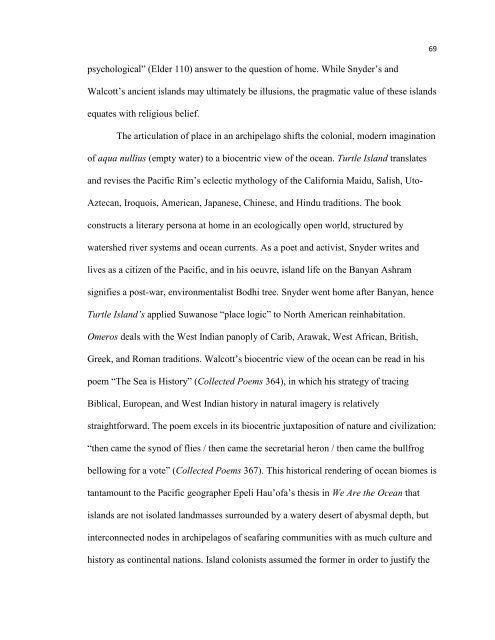RE-INHABITING THE ISLANDS - The University of North Carolina at ...
RE-INHABITING THE ISLANDS - The University of North Carolina at ...
RE-INHABITING THE ISLANDS - The University of North Carolina at ...
You also want an ePaper? Increase the reach of your titles
YUMPU automatically turns print PDFs into web optimized ePapers that Google loves.
69<br />
psychological‖ (Elder 110) answer to the question <strong>of</strong> home. While Snyder‘s and<br />
Walcott‘s ancient islands may ultim<strong>at</strong>ely be illusions, the pragm<strong>at</strong>ic value <strong>of</strong> these islands<br />
equ<strong>at</strong>es with religious belief.<br />
<strong>The</strong> articul<strong>at</strong>ion <strong>of</strong> place in an archipelago shifts the colonial, modern imagin<strong>at</strong>ion<br />
<strong>of</strong> aqua nullius (empty w<strong>at</strong>er) to a biocentric view <strong>of</strong> the ocean. Turtle Island transl<strong>at</strong>es<br />
and revises the Pacific Rim‘s eclectic mythology <strong>of</strong> the California Maidu, Salish, Uto-<br />
Aztecan, Iroquois, American, Japanese, Chinese, and Hindu traditions. <strong>The</strong> book<br />
constructs a literary persona <strong>at</strong> home in an ecologically open world, structured by<br />
w<strong>at</strong>ershed river systems and ocean currents. As a poet and activist, Snyder writes and<br />
lives as a citizen <strong>of</strong> the Pacific, and in his oeuvre, island life on the Banyan Ashram<br />
signifies a post-war, environmentalist Bodhi tree. Snyder went home after Banyan, hence<br />
Turtle Island’s applied Suwanose ―place logic‖ to <strong>North</strong> American reinhabit<strong>at</strong>ion.<br />
Omeros deals with the West Indian panoply <strong>of</strong> Carib, Arawak, West African, British,<br />
Greek, and Roman traditions. Walcott‘s biocentric view <strong>of</strong> the ocean can be read in his<br />
poem ―<strong>The</strong> Sea is History‖ (Collected Poems 364), in which his str<strong>at</strong>egy <strong>of</strong> tracing<br />
Biblical, European, and West Indian history in n<strong>at</strong>ural imagery is rel<strong>at</strong>ively<br />
straightforward. <strong>The</strong> poem excels in its biocentric juxtaposition <strong>of</strong> n<strong>at</strong>ure and civiliz<strong>at</strong>ion:<br />
―then came the synod <strong>of</strong> flies / then came the secretarial heron / then came the bullfrog<br />
bellowing for a vote‖ (Collected Poems 367). This historical rendering <strong>of</strong> ocean biomes is<br />
tantamount to the Pacific geographer Epeli Hau‘<strong>of</strong>a‘s thesis in We Are the Ocean th<strong>at</strong><br />
islands are not isol<strong>at</strong>ed landmasses surrounded by a w<strong>at</strong>ery desert <strong>of</strong> abysmal depth, but<br />
interconnected nodes in archipelagos <strong>of</strong> seafaring communities with as much culture and<br />
history as continental n<strong>at</strong>ions. Island colonists assumed the former in order to justify the
















